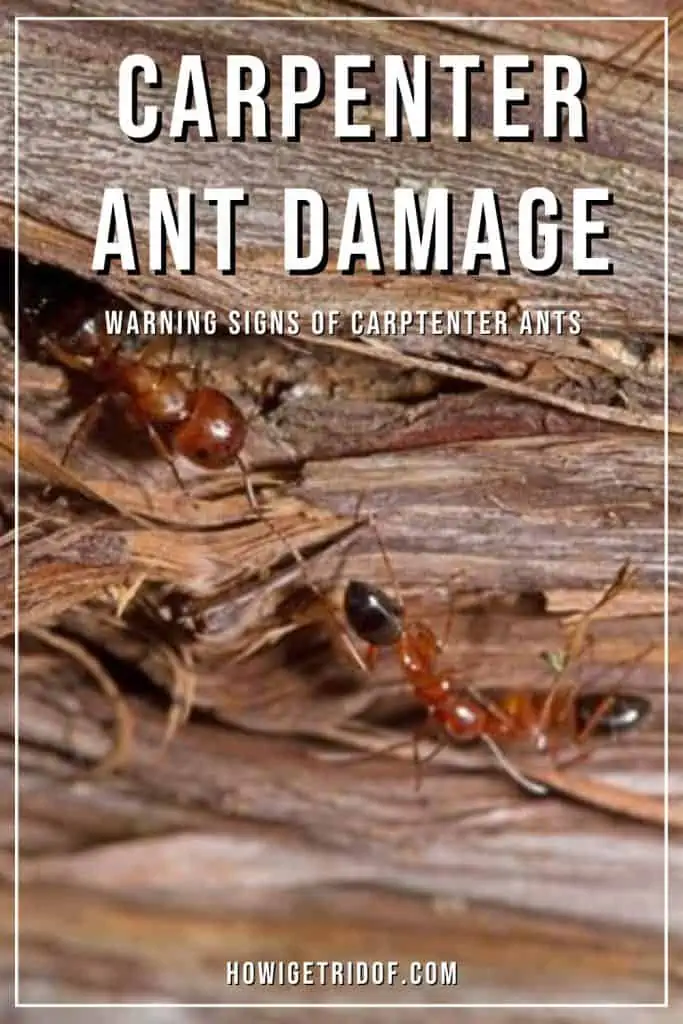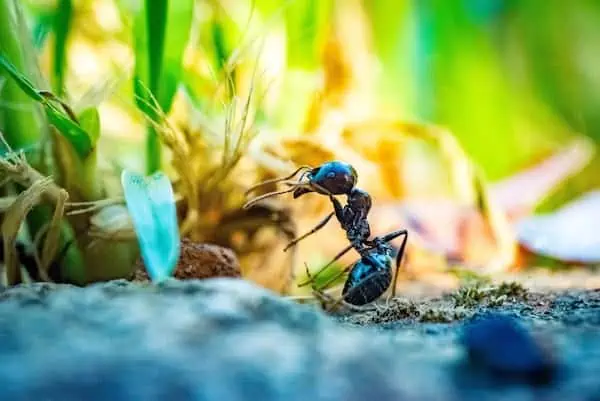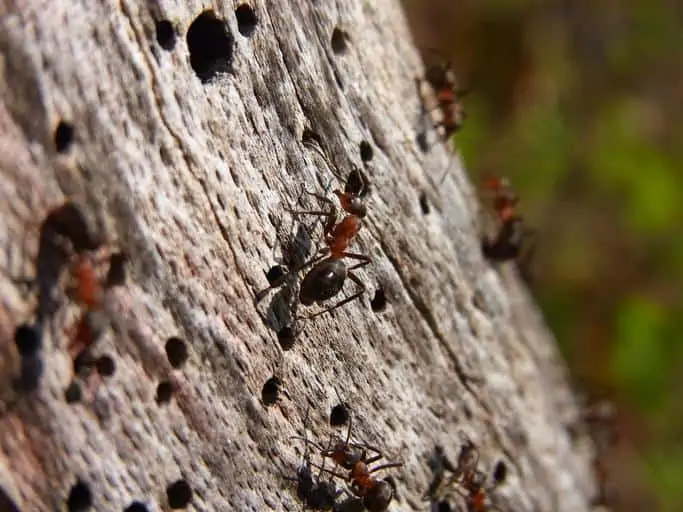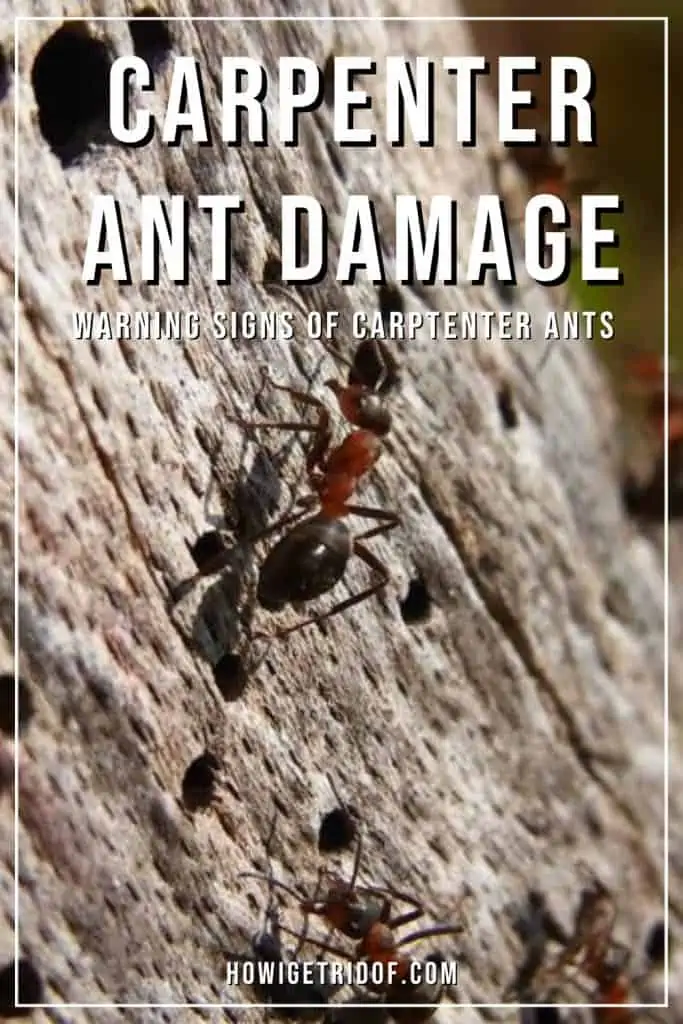Carpenter ants are large, black ants that can be found in wood and wood products. The name “carpenter ant” comes from the fact that these pests will often hollow out wood to make their nests.
In order to protect your home from carpenter ant damage, it’s important to know what attracts them, how to identify these pests and what sort of signs should be looked for when attempting to detect infestations.
Do you know what to look for when it comes to carpenter ant damage? If not, keep reading to find out!
Contents
What Are Carpenter Ants
Carpenter ants are large ants known to bore into wood.
Carpenter ants, also known as wood ants, are a common type of ant found throughout the United States. Carpenter ants build their nests in wood that is damp and decaying. They can be found inside homes, but are more commonly found outside.
The carpenter ant has three stages in its life cycle including egg, larva, and adult. The queen lays eggs that hatch into larvae that look like wingless ants. When mature, female carpenter ants can develop wings.
The winged ants mate and then lay eggs in cracks and crevices in decaying wood or other materials where they will develop into larvae. Carpenter ant larvae pupate into adults within these cracks and crevices as well. The pupae stage lasts several weeks before an ant emerges as an adult with functional wings (if it has matured).
n
Carpenter ants outdoors prefer to live in moist areas such as under stumps, rotting logs, and decks. They also can be found under eaves, window sills, and in cracks in foundations or sidewalks. Indoors, carpenter ants prefer to live in moist areas such as kitchen cabinets, bathroom sinks, or under the kitchen sink where it is warm and damp from leaking pipes or water spills on countertops.
Carpenter ants are not known to carry disease or sting people or pets. They are, however, a major pest in homes and commercial buildings. These insects live in colonies made up of workers, soldiers, queens and drones. The queen is the only fertile female in the colony, which is why she is so important when it comes to carpenter ant damage and control if you want to get rid of these pests for good.
Workers are all females and don’t reproduce. Soldiers defend the colony against intruders such as other insects or predators that try to kill the queen and other members of the colony. Drones mate with queens during nuptial flights in spring through early summer before dying off later that same year due to a lack of food resources available during winter months when cold temperatures prevent them from going outside looking for food sources.
What Attracts Carpenter Ants
These ants have large mandibles they use to chew into wood and other surfaces.
Carpenter ants are attracted to moisture, so if you have water leaks, plumbing problems, or damp wood, you may be at risk of infestation. Carpenter ants also love wood that has been treated with preservatives containing arsenic. They can’t digest the arsenic, but they do enjoy feeding on it.
Carpenter ants are social insects that live in colonies, as we mentioned above. The queen lays eggs and lives for years. The workers take care of the colony’s needs and forage for food. Some carpenter ant species nest outside in dead trees or other wood structures; others build nests inside homes or other buildings.
Carpenter ants are specifically attracted to the following:
Wood. Carpenter ants build their nests in wood, so they’re often found in and around structures made of wood. They also build their nests in or near wood like trees, stumps, or logs. However, unlike termites, carpenter ants do not eat the wood. Instead, they hollow wood out to lay their eggs and raise their young.
Moisture. Carpenter ants need moisture to survive, so they’re often found in damp places like basements and crawl spaces. They may also be found under kitchen sinks or in bathrooms if there are leaky pipes.
Food scraps. Like many types of ants, carpenter ants can be attracted to food scraps. This means if you’ve got food lying around inside or outside your home, you may wind up with an ant problem.
Plants that produce nectar and pollen. Carpenter ants aren’t only attracted to wood – they also love plants that produce nectar and pollen, especially those with large flowers such as honey locust trees, tulip poplars, and dogwoods.
How To Identify Carpenter Ants – What Do These Pests Look Like?
Carpenter ants can range in color from black to red.
Carpenter ants are some of the most common types of ants to infest homes. They can be a serious problem if left untreated, but identifying them is relatively easy when you know what to look for.
Carpenter ants are between 1/4 and 1/2 inch long with dark brown or black bodies and reddish-brown heads and thoraxes (the middle part of the body). They have six legs, and the abdomen is segmented into two parts: a narrow waist section called a petiole followed by a broad gaster (abdominal segments). Each segment has two pairs of spines on its back side that help protect it from predators while it’s underground tunneling through wood or soil.
Termites vs. Carpenter Ants – What Is The Difference?
Termite droppings – Termites leave behind fecal pellets (small, light brown balls) that look like grains of rice; these droppings can accumulate on windowsills or baseboards because termites tend to travel along walls when looking for food sources such as wood inside your home. Carpenter ants, on the other hand, do not leave behind any droppings at all.
Carpenter ant size – Carpenters are larger than most other ant species and have a very distinctive appearance with their large heads and thoraxes. They also have hair-like projections on their bodies called “cerci” that help protect them from predators. You can also identify carpenter ants by the presence of their large mounds in your yard or garden where they build their nests.
Termite damage – When termites feed on wood within your home, they leave behind small holes that appear as if someone has drilled into the surface of whatever material they are infesting (e.g., wood). These holes are about 1/4 inch wide and can be found in many different areas of your home including window frames, door frames, and even furniture.
Carpenter ant damage – Carpenter ants will build their nests inside your walls or under your home’s foundation where they can hide from predators. They prefer to nest in wood because it provides them with shelter from the elements as well as protection against other insects that could prey on them. Like termites, carpenter ants also cause damage by tunneling through wood but unlike termites, their tunnels do not resemble those made by termites; instead, they create large round holes in the surface of whatever material they are infesting.
What Are Some Common Signs Of Carpenter Ant Damage?
Damage caused by carpenter ants can look like small holes.
Carpenter ants are commonly found in the southern United States and some parts of the Midwest. As we mentioned above, they are known to cause significant damage to wooden structures. This is because they chew on wood and create galleries within the wood. If you live in an area where carpenter ants are prevalent, then it is important that you know how to identify carpenter ants and carpenter ant damage so you can learn how to treat them if necessary.
Some common signs of carpenter ants and carpenter ant damage are listed below.
Hearing Strange Sounds
If you’re hearing strange sounds coming from inside your walls or attic, there’s a good chance it’s caused by carpenter ants causing carpenter ant damage. The sound is caused by the chewing they do in the wood to build their nests. You may also notice piles of sawdust on the ground near where these pests have been working.
Finding Strange Holes In Wood
Carpenter ants often make their presence known by creating small holes in wood or other materials like cardboard or paper products. These holes may appear as small pinholes or larger holes that are approximately 1/16-inch wide. You may see these holes if you look closely at objects such as furniture, wooden beams, doors etc., but they tend to be more noticeable on smooth surfaces like walls rather than rough ones like tree bark or fence boards.
Finding Wood Shavings Around Your Home Or Property
Another sign that you might have a carpenter ant problem or that you may need to tend to carpenter ant damage is finding wood shavings around your home or property. These shavings are usually left behind when carpenter ants are boring into wood, so it’s not uncommon to find piles of wood shaving near an entrance hole in your home or other wooden structures like sheds and decks.
Finding Ant Trails or Paths
Carpenter ants build their nests in dead trees or stumps, so they can easily find their way back home when they leave their nest. If you notice ant trails or paths coming from a specific area of your house, you may have an infestation on your hands. Check for holes in the siding or other areas where the ants could be entering your home through cracks and crevices.
Wood That Appears Water Damaged Or Rotten
Carpenter ants will tunnel through any type of wood material as long as it is soft enough for them to chew through. This includes decks, fence posts and any type of exterior trim work around your house. You may notice that some areas of these surfaces look rotten or water damaged even though there has been no visible water damage to those areas.
Seeing Shed Wings
The presence of carpenter ants can be detected by observing several signs. One of the most common signs is the presence of shed wings on windowsills or other areas around the home. With many species of carpenter ants, it is possible to see workers leaving their nests with their wings still attached. The shed wings will eventually drop off when they dry out or become dislodged by movement within the colony.
Seeing The Carpenter Ants Themselves
Carpenter ants are usually grayish-black or black with orange or red legs. You may see them roaming around on the floor during the day if they’re looking for food, but they won’t be present all year long because they live underground during winter months when it’s too cold outside for them to survive.
Best Products For Getting Rid Of Current Carpenter Ants In Your Home
Some of the best products to get rid of carpenter ants are made with natural ingredients.
When the carpenter ants invade your home, you need to act fast. There are many options for killing carpenter ants, but not all of them will get the job done. You’ll want to choose a product that is effective yet safe for you, your family and your pets.
There are two main types of products used in ant removal: natural and chemical. Natural products include boric acid powder, essential oils, neem oil, or a bait and sugar water spray. Chemical pesticides could be more toxic than natural products and may have more of an impact on the environment, but they can be more effective at killing carpenter ants quickly.
Keep in mind that a good carpenter ant killer contains both a contact insecticide and an insect growth regulator (IGR). The contact insecticide kills adult ants on contact, while the IGR prevents them from reproducing by interrupting their life cycle.
The best products for carpenter ant removal depend on what type of treatment you’re looking for and where you live. Those with children and pets may choose to forgo chemical insecticides and favor natural ones.
However, a severe infestation of carpenter ants or a home with severe carpenter ant damage may choose to use a number of different products and methods to get rid of these pests.
If you’re not sure which type of product would be best for you, we have listed some of the best products we recommend for removing carpenter ants below.
TERRO Liquid Ant Killer Bait Stations
No products found.
One effective way to control carpenter ants is by using TERRO Liquid Ant Killer Bait Stations. These stations contain an appetizing liquid that attracts the ants in droves, but they also contain an effective insecticide that kills them quickly. This bait can also help kill the queen and get rid of entire colonies.
Carpenter ants typically nest outdoors under rocks or logs, so you should check these areas regularly for carpenter ant activity before treating them with Terro Liquid Ant Killer Bait Stations. If you find activity in these locations, simply place one bait station per treatment point into the area where you found the activity, and let it go to work on your behalf.
EcoRaider Ant Killer & Crawling Insect Killer
No products found.
EcoRaider Ant Killer & Crawling Insect Killer is a professional strength product designed to kill all types of ants, including the carpenter ant. This product works by attacking the digestive system of the ant and preventing it from digesting food. The active ingredient in EcoRaider Ant Killer & Crawling Insect Killer is boric acid, which is a naturally occurring mineral found in soil and volcanic areas.
You can use this spray by applying directly to nesting sites. Use a spray bottle to apply the insecticide directly onto nesting sites or trails where you have seen ants foraging for food and water. Spray around cracks and crevices in your home or business where you have seen ants entering or exiting.
HARRIS Carpenter Ant Killer
No products found.
HARRIS Carpenter Ant Killer is a ready-to-use product that is simple to apply to help get rid of current carpenter ants and prevent future carpenter ant damage. To combat carpenter ants, simply spray the liquid where you see them. It will kill them on contact.
The active ingredient in HARRIS Carpenter Ant Killer is borax, which has been used for years by professional pest control companies. Borax is a natural mineral that is safe for people and pets and can be found in many products such as laundry detergent and toothpaste.
The product works best when applied directly on the ant colony or around its entrance point. The active ingredient in Harris Carpenter Ant Killer will slowly dissolve into the soil and kill all ants that come in contact with it for up to one year.
Best Products For Preventing Future Carpenter Ants
Preventing carpenter ants means using products that will keep them from breeding and returning.
As we now know, carpenter ants are destructive insects that can cause serious damage to your home. It is difficult to get rid of carpenter ants once you have them and it can be costly to repair carpenter ant damage.
For this reason, along with knowing the signs of carpenter ant damage and with understanding how to get rid of current carpenter ants, homeowners should also be aware of how to prevent these pests.
Preventing carpenter ants means using a variety of methods from home maintenance techniques to investing in the right products like repellents.
Carpenter ant repellent comes in many forms, including aerosol sprays, dry repellents, and even granular pesticides. However, the most effective way to repel these pests is with a combination of products, as we discussed above.
Two of the most common active ingredients used in carpenter ant repellents include:
Naphthalene (0.025%) – this chemical is found in mothballs, which repels many types of insects including ants. It is not considered as effective for killing current carpenter ants because it does not kill on contact; instead, it deters these pests because it has a strong odor that they are repulsed by. This is what makes it a great repellent to keep carpenter ants and carpenter ant damage at bay.
Deltamethrin (0.01%) – this chemical is found in DEET-based insect repellents and works by disrupting an insect’s nervous system upon contact. It is effective against carpenter ants but not as effective as some other products due to its low concentration in most products available for purchase. However, it can make a good repellent and help keep carpenter ants at bay when applied correctly. Ants will be able to detect the smell of this product and avoid it.
Other repellents can be made of natural ingredients such as essential oils like peppermint, tea tree oil, cinnamon oil, lavender oil, or citronella oil.
Along with using repellent products to prevent carpenter ant damage, we also recommend treating the wood around your home that might be vulnerable to carpenter ant damage and termite damage.
Take a look below at a few products we recommend to help prevent carpenter damage before it starts.
Mighty Mint Ant Killer and Repellent Spray
No products found.
A great way to repel carpenter ants and prevent carpenter ant damage is to use an essential oil spray that contains peppermint. If you want an all-natural, non-toxic way to deter these pests from invading your home, consider using the Mighty Mint Ant Killer and Repellent Spray on a regular basis. This product uses peppermint oil as its active ingredient and is non-toxic for humans and pets alike.
To use this product most effectively, spray it along baseboards, window sills and doorways where you’ve seen ant activity.
Wondercide Outdoor Pest Control Spray
No products found.
Wondercide is an all-natural way to control pests in your yard and garden. The Wondercide Outdoor Pest Control Spray is a natural, non-toxic solution for repelling and killing ants, spiders, and other insects.
To prevent carpenter ants with the Wondercide Outdoor Pest Control Spray, make sure any areas where water collects are drained and dry. This includes basements, under decks and porches, around gutters, windowsills and foundation walls.
Keep wood surfaces (such as deck railings) dry by painting them with a sealant to help prevent the growth of mold and mildew which attracts carpenter ants in the first place!
Next, spray your yard and the perimeter of your home with Wondercide Outdoor Pest Control Spray. The product works using all natural plant-based ingredients like essential oils that will work to repel carpenter ants and protect your home from carpenter ant damage.
Best of all, this product is safe to use around children, pets, and the environment.
Best Home Remedies For Carpenter Ants And Carpenter Ant Damage
Cinnamon can help protect the wood around your home from carpenter ant damage.
Most people already know that ants are a common problem for homeowners. However, many people are not aware that carpenter ants are especially problematic because they can cause serious structural damage to your home.
Remember, carpenter ants are attracted to moisture and decaying wood. They make their homes in damp, decaying wood that’s close to the ground or water sources. You may find them in your basement, crawlspace or under porches.
If you have a carpenter ant infestation, there are several home remedies you can use to help get rid of them. And if you already have carpenter ant damage, there are a few methods to help treat the wood and protect it from future destruction.
Repel Carpenter Ants Using Essential Oils
Many insects including ants don’t like the smell of certain essential oils such as citronella and peppermint, so sprinkling these scents around your home may help deter carpenter ants from entering it in search of food or water.
You can use essential oils directly on ant trails or mix them with water and spray them onto surfaces where ants are likely to travel. You can also add about 15 drops of peppermint oil or citronella oil per cup of water before spraying it onto surfaces where you have noticed carpenter ant activity. For the best results and to prevent carpenter ant damage, spray surfaces at least once every three days.
How to clean ant trails using vinegar and soapy water
The first step in getting rid of carpenter ants is to clean up any scent trails they have made around your home that might attract other ants. You can use a mixture of vinegar and soapy water to kill them as they go back and forth between their nests and food sources. This will help prevent future infestations from occurring in the same area again.
To make vinegar and soap spray, add equal parts apple cider vinegar to equal parts water in a spray bottle. Add a few drops of liquid dish soap and mix the solution until sudsy. Then spray down areas you have noticed ant activity.
How to repair carpenter ant damage at home
Carpenter ants will chew through wood that has softened due to moisture or decay, creating tunnels that weaken your structure. They can cause significant structural problems if they nest inside walls, ceilings, or floors in your home. In addition to chewing through wood, carpenter ants can also destroy furniture by tunneling into it and creating galleries inside the wood that connect multiple chambers within each gallery.
If wood is not yet too damaged, you can prevent carpenter ants from returning by spraying the wood down with an essential oil solution or by covering the wood in ground cinnamon.
Unfortunately, most wood that has sustained serious carpenter ant damage should be repaired or replaced due to structural or safety purposes.
How to use companion planting around your home to repel carpenter ants
Companion planting around your home can help deter carpenter ants from entering your home in the first place. Plants like mint, rosemary and garlic all have strong scents that make it difficult for insects like carpenter ants to navigate through them without getting confused or disoriented along the way. These plants also attract beneficial insects that eat pests such as aphids which can help keep other pests away from your home.
Expert Tips On Repairing Carpenter Ant Damage
Keeping carpenter ants under control is about using a combination of methods.
Carpenter ants are wood-loving insects that can be a problem for homeowners. They can damage the wood of your home and cause other problems. However, you can keep them away from your home by taking the right precautions. Here are some expert tips for preventing carpenter ant damage.
The first step in preventing carpenter ant problems is to keep up with regular maintenance around your home. This includes cleaning gutters and downspouts, performing yard work, keeping up with landscaping and mowing grass regularly. You also want to make sure your roof is in good shape and that there are no leaks or cracks in it.
Use a routine form of pest control to keep carpenter ants at bay. You should also use a routine form of pest control around your home to help prevent carpenter ants from entering it in the first place. There are several types of pesticides available that you can use around your home on a regular basis to keep pests like carpenter ants away from you when they’re in search of food sources.
It’s very important that you remove excess wood sources outside of your home if you want to avoid having carpenter ants. You can also use certain products to repel carpenter ants and protect the wood and trees you have outside of your home that you want to keep.
Remember, carpenter ants will often build their nests in trees or other structures close to where they found food sources. You should keep an eye on any extra wood lying around outside of your home so that you can remove it before it becomes a problem for you.
And last but not least, call a professional if the problem persists. While carpenter ants are not dangerous themselves to people or pets, carpenter ant damage can be dangerous to the structure of your home if it gets out of control.
Best of luck and thanks for reading!


Jack founded our blog after two decades of working in the pest control industry. His vast experience dealing with a wide array of pests allows him to diagnose issues quickly and get to the heart of pest problems quickly and effectively. He has serviced more than 2,000 homes over his career and there is hardly any pest situation that he has not seen before.








